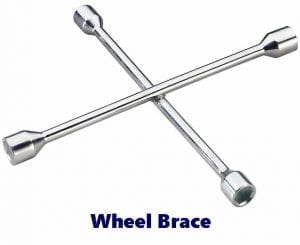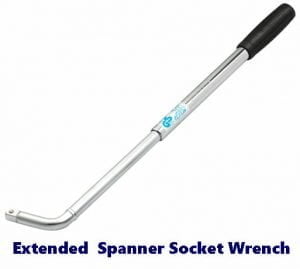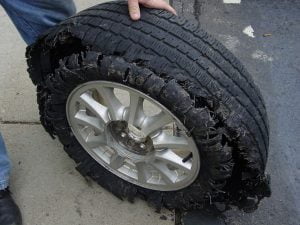Well you could wait for the AA/RAC person to come and fix it which usually takes 1 – 2 hours before they arrive, or fix it yourself.
Next Question: Where are you when first become aware of it?
Travelling on a motorway at 70 MPH and the front tyre blows out can be a life threatening situation. Whereas walking out your house and seeing a deflated tyre on your drive or kerbside is merely a nuisance.
One way or the other either the tyre needs to be pumped up, or the wheel needs to be changed for the spare wheel that you have in the boot of your car. It is worth mentioning here that whenever you check the tyre pressures in a Petrol Station do not forget the spare tyre.
So let’s get this wheel changed for the spare and get on with our journey as soon as possible and change the flat tyre wheel for the spare in the Boot and do it ourselves.
There is a certain sequence of events that you need to go through to do this Safely and quickly.
- The car should be in gear with the handbrake fully on.
- There is usually a Hub Cap covering the wheel nuts. This has to be prised off with a screwdriver.
- Have the Jack ready but do not use it yet. Instead loosen the wheel nuts very very slightly. Because the wheels are still on the ground and have not been raised by the jack, the friction with the ground will hold the wheel steady while you slightly loosed the wheel retaining nuts.
- Once the nuts have been moved a bit (the tiniest bit) use the cars jack to raise and remove the nuts and the wheel will come off.
- Now put spare wheel on and tighten the nuts with the spanner or wheel brace that was supplied with the car.
- It is hard to tighten the nuts with the wheel in mid air so for now just get the wheel on and tighten the nuts firmly but not to their full tightness yet.
- Lower and remove the jack and tighten the nuts to their full tightness. Usually around 140 Nm
If you want to get technical:
Newton meters (Nm) is the way that twisting force is measured. The higher the number in NM, the more torque is transmitted.
Where this can all go wrong, especially on a bitter cold night at the side of the Motorway is that someone has done the wheel nuts up too tight and NO amount of straining with the spanner or wheel Brace will shift the nut.
You suspect that the wheel has been over tightened with an air driven impact wrench, but in places like Kwik Fit the impact wrenches are set to the correct Newton meters (Nm) so that is unlikely to be the problem.


More likely someone has really leaned on the Wheel Brace or used and extended spanner.
All about Impact Wrenches sold in the UK (Advert)
Impact Wrenches come in 3 types
The Air Driven Pneumatic Impact Wrench.
- This is the usual type that you see in Tyre Depots where they are changing wheels many times per day.
- They come in Three main sizes and they all require an Air compressor to run them. The bigger the drive the more air they require as can be seen below
- ½ Inch Drive for Cars and small vans. Requires 5 cfm (FAD) Free Air delivered
- ¾ Inch Drive for Medium size vans Requires 8.5 cfm (FAD) Free Air delivered.
- 1 Inch Drive for Lorry and Truck wheels Requires 10 to 12 cfm (FAD) Free Air delivered.
The Mains Driven (Corded) Impact Wrench
- Easy to use and before the advent of Li-ion Batteries was the most popular amongst the DIY home users for Cars and Bikes. The only downside being that you are tied to a cord
The Battery Driven (Cordless) Impact Wrench
- At the moment, air impact wrenches are the most popular with professionals, but, as battery technology improves, the cordless impact wrench will become increasingly popular, less expensive, and come to dominate the market.These cordless wrenches take power from batteries, either from nickel-cadmium type. NiCAD or the more modern lithium-ion batteries Li-Ion . Lithium-ion batteries are smaller and lighter than the equivalent NiCad battery. But Lithium-ion batteries are also two to three times more expensive than NiCad ones.These batteries range up to 28 volts, starting from 18 volts, and a 54 volt one is coming on the Market soon.As you do not need a power or Compressed Air supply, you can use them anywhere making them ideal for the mobile mechanic or Scaffolder
When purchasing a Cordless Battery driven Impact Wrench, make sure you get one with at least one spare battery.
- At the moment, air impact wrenches are the most popular with professionals, but, as battery technology improves, the cordless impact wrench will become increasingly popular, less expensive, and come to dominate the market.These cordless wrenches take power from batteries, either from nickel-cadmium type. NiCAD or the more modern lithium-ion batteries Li-Ion . Lithium-ion batteries are smaller and lighter than the equivalent NiCad battery. But Lithium-ion batteries are also two to three times more expensive than NiCad ones.These batteries range up to 28 volts, starting from 18 volts, and a 54 volt one is coming on the Market soon.As you do not need a power or Compressed Air supply, you can use them anywhere making them ideal for the mobile mechanic or Scaffolder
Now that you understand some thing about what is available in IMPACT WRENCHES Take a look at the whole range of ELECTRIC Wrenches from UK Manufacturers
And you should also take a look at some of the Compressed Air Driven Wrenches
This will also show you who is selling them at the lowest price
For a real good explanation of what an Impact Wrench is and how it works, it is worth taking a look at Wikipedia




